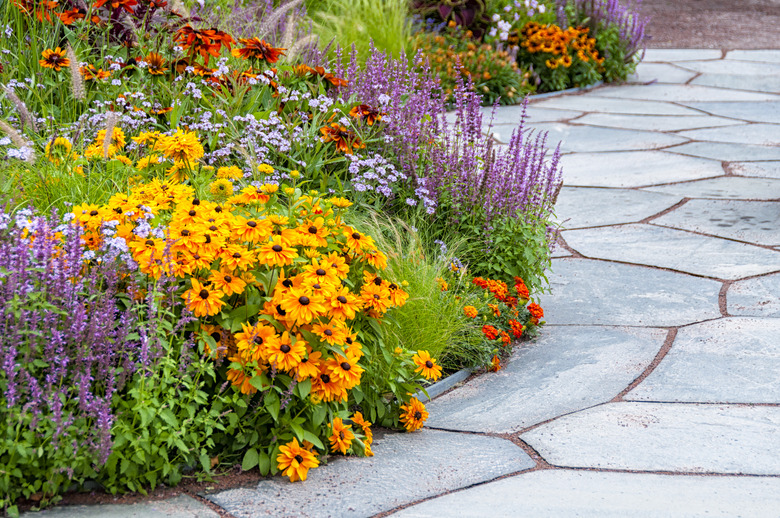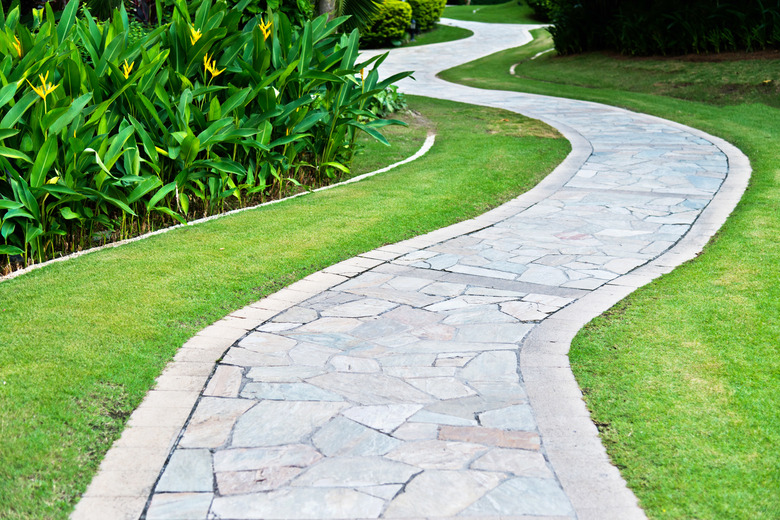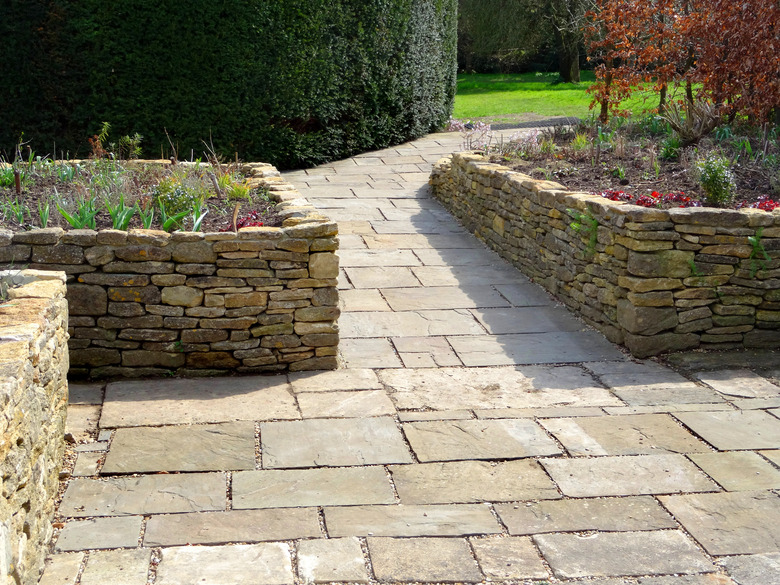Building A Flagstone Garden Path Or Walkway
We may receive a commission on purchases made from links.
If you're looking for a walkway that will give your outdoor area a unique, natural look, a flagstone walkway is a durable, decorative option. One of the primary benefits of using flagstone to build a garden path is that it comes in many shapes and sizes and can be arranged symmetrically or in irregular pieces. Your path can cut straight through your garden or yard or wind through it in different patterns.
Installing a flagstone path is a great DIY project because it doesn't require any landscaping experience or technical skills. You simply set slabs of stone on a bed of sand or mortar. If you have a strong back, a wheelbarrow and a shovel, chances are excellent that you can lay the perfect walkway for your area. It's similar to a jigsaw puzzle in that you will be setting pieces in a pattern to build the right design, although because these pieces are made of heavy stone instead of cardboard, it can be labor intensive and time consuming.
What Is Flagstone?
What Is Flagstone?
Flagstone is a general term for stone that is cut or cleaved into relatively thin, flat sheets and then chiseled into shape. Flagstone does not get its name from the type of rock from which it comes but rather from the way it is cut into layers, or "flagged." The strongest, most durable flagstone is cut from metamorphic rocks and includes marble and quartz. Igneous stone such as granite is a little softer, while sedimentary rocks are softer still and are the easiest to cut and chisel into flagstones. These include sandstone and limestone among others.
The type of stone used for flagstone will determine how durable it is. Marble, for example, is a very tough and durable stone. Sedimentary rocks like sandstone will still last a long time but are more likely to flake and wear over time. The thickness of a flagstone is also a factor in its durability, and a thicker stone will last longer. According to Old House Online, flagstone usually ranges in thickness from 1 inch to 3 inches and comes in several colors including red, brown and pink but is also available in a few less-common colors such as blue, green and lilac.
The two common types of flagstone are patio and select. To build a flagstone walkway, you will want to use patio flagstone, which comes in pieces that are both thicker and smaller, around 12 to 18 inches across. Select flagstone, or standup flagstone, is often used for building flagstone walls and comes in pieces that are thin and large, measuring between 18 and 36 inches. Patio flagstone is usually packed and shipped horizontally to prevent damage to the slabs, while select flagstone is usually packed vertically.
Selecting the Right Flagstone
Selecting the Right Flagstone
The size of the flagstone you choose for your DIY project will depend on the function of your path or walkway. If the path will receive heavy foot traffic, the flagstone should be a durable type and at least 1 1/2 inches thick. If the path is more decorative than functional, you can probably get away with a thinner stone.
How you lay the flagstones will also help determine the best thickness. If you plan to set the stones in sand or soil, a thicker slab will be required for extra durability. Thinner stones are more likely to crack in sand or soil, but when laying them in a bed of concrete, you can use thinner slabs without fear of cracking. Whichever thickness you use, it is important that the stones are even and level. A path surface with lots of ups and downs or tilting stones makes for uncomfortable walking and creates a tripping hazard.
While you want your flagstone walkway to be durable enough to last, another important consideration is the surface of the stone. Different types of flagstone have different textures and, more importantly, absorb water differently. Some flagstones are less porous and will bead up and become slippery when wet, while others absorb water very well. You certainly don't want a slippery walkway in your garden or yard, so be sure to check this out before buying the stone.
Flagstone is usually sold by the square foot. Flagstone is typically cut and chipped into irregular shapes and sizes, and unlike brick and other pavers with a uniform shape and size, it can be difficult to determine exactly how much or how many you will need. When estimating how many stones you will need to purchase, add an extra 10 percent. This will provide a few additional flagstones if your calculations were off, if the design turns out differently than you planned or if a few stones break during installation.
The best place to find flagstone is through local masonry and landscape suppliers. Many dealers specialize in local stone varieties, which helps cut down on costs. Stone from your region also pairs well with local native plants.
Flagstone Path Designs
Flagstone Path Designs
One of the real benefits of using flagstone for a walkway is that it can be designed and shaped in so many different ways. There are so many different types of designs available for walkway ideas, including a straight layout in which cut flagstone is set in a rectangular or square pattern and installed in a straight line that will give your flagstone pathway an elegant look. You can also space them apart in a straight line, giving them the appearance of stepping stones. A walkway with curves or bends, on the other hand, is a more informal design using randomly shaped and sized flagstone and results in a more casual look than a straight-line pathway.
Using naturally or irregularly shaped flagstones for your walkway is another design option. Larger irregularly shaped stones can be spaced far enough apart that grass and other ground cover plants can grow in the spaces of the pathway and give your path a casual, inviting appearance. Pea gravel can also be used to fill the area between stones. If you prefer a more organized and formal appearance, you can use cut or milled stone that is cut into uniform shapes and sizes.
You can also choose to build a multicolored pathway or choose a single color of flagstone for your walkway. Some homeowners enjoy the continuity of a single color that doesn't draw attention from the surrounding beauty, while others like to use different-colored flagstones to accentuate a feeling of warmth or vibrancy and make the walkway a main focal point of the landscape.
A very important factor when considering the design of your flagstone walkway is whether the stones will be set in mortar or in sand or gravel. Dry-laid, or sand-set, flagstone is installed on top of a prepared base at least 3 inches thick and consisting of gravel and sand. The gravel is compacted to provide a level, solid base for the flagstones. A dry-laid flagstone path is a more common and less expensive choice for a flagstone walkway in a garden.
Mortared flagstone is best installed over an existing concrete path or walkway. It's possible to set mortared stone over compacted gravel, but this type of path is much more likely to crack due to seasonal freeze-thaw cycles, especially in climates with cold winters. Mortared flagstone is a more expensive option that is less natural in appearance, but the benefit is that it provides a more durable path that will retain a secure and level walking surface for many years.
Installing a Flagstone Walkway
Installing a Flagstone Walkway
The project begins by marking the path from beginning to end with wooden stakes. Then the shovels come out, and the hard part begins. The soil should be dug along the pathway to a depth of approximately 6 inches with a level being used regularly to keep it even. Once the path is cleared, a piece of landscaping fabric can be laid on the path. This is not a necessary part of the installation, but it will help prevent weeds from growing and will save you from a lot of bending and weeding in the future.
The area is then filled with crushed gravel, which is compacted and leveled along the way. A handy trick that helps to provide a solid base is to fill the area with 2 or 3 inches of gravel, tamping and compacting it until it is level and then pouring in another layer and compacting until it is ready for the flagstone. When laying the flagstone, it's a good idea to use some of the better, larger stones at each end of the walkway. How you space them will depend in part on whether you want a formal or informal design, but either way, the spaces should be narrower where there is more foot traffic and wider at the edges of the walkway.
The stones should be laid flat, level and secure, which may require some digging and resetting. Once the path is complete and level with the stones set solidly in place, the gaps between the flagstones can be filled in with sand or a soil mix where grass or other ground cover can be planted. Then, the entire walkway can be watered, and as everything settles, the flagstones can be tamped with a rubber mallet to set them firmly in place. More fill can be added to the gaps as required. For a more decorative look, different-colored rock or gravel can be used to fill in the gaps between the flagstones.


